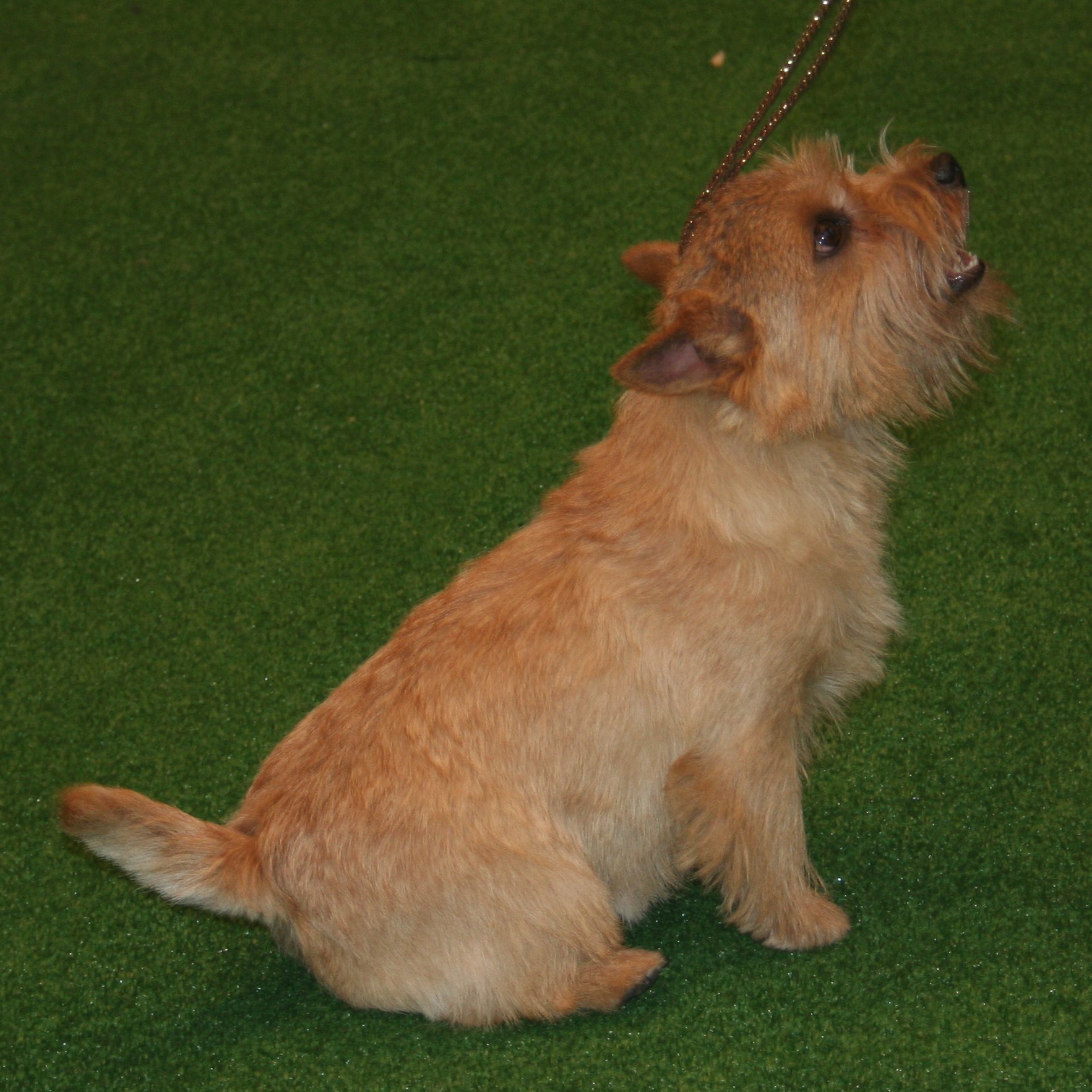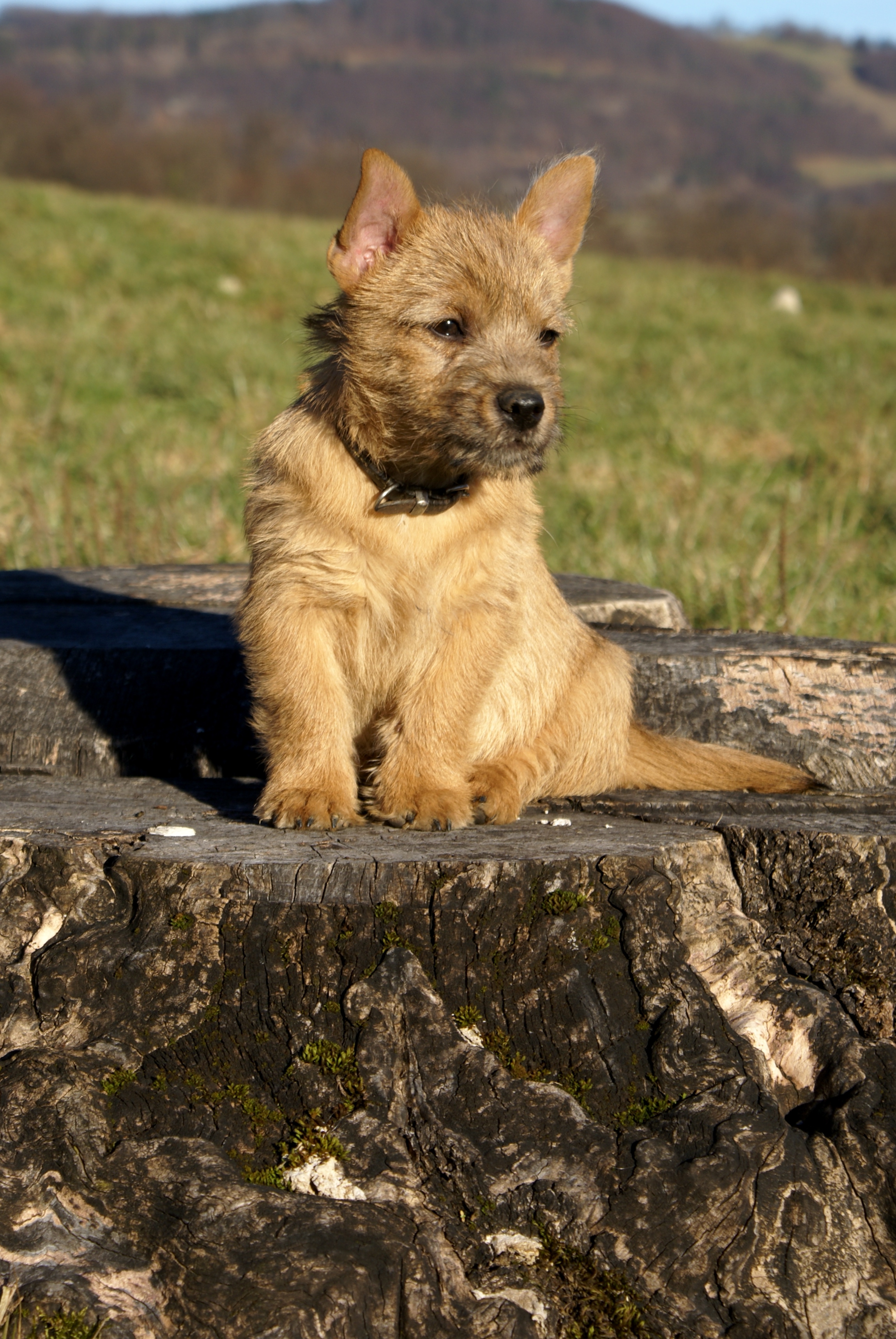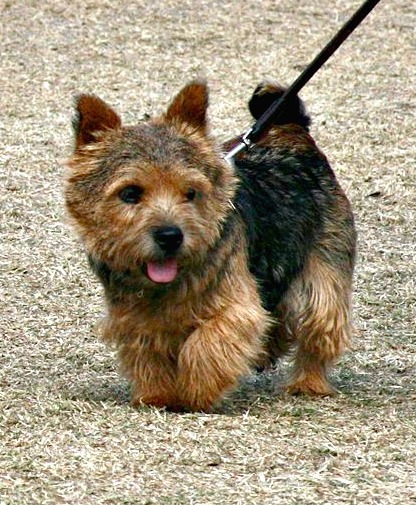Norwich Terrier on:
[Wikipedia]
[Google]
[Amazon]
The Norwich Terrier is a


 A US study of over 90,000 dogs found the Norwich Terrier to be the second most predisposed breed to portosystemic shunt with 7.41% of dogs being affected compared to 0.35% for mixed-breed dogs.
A retrospective study on
A US study of over 90,000 dogs found the Norwich Terrier to be the second most predisposed breed to portosystemic shunt with 7.41% of dogs being affected compared to 0.35% for mixed-breed dogs.
A retrospective study on

 In 2018, both Norfolk and Norwich terriers appeared on the Kennel Club's list of most vulnerable dog breeds, with the Norwich breed having fewer than 300 births per year.
In 2018, both Norfolk and Norwich terriers appeared on the Kennel Club's list of most vulnerable dog breeds, with the Norwich breed having fewer than 300 births per year.
breed
A breed is a specific group of breedable domestic animals having homogeneous appearance (phenotype), homogeneous behavior, and/or other characteristics that distinguish it from other organisms of the same species. In literature, there exist seve ...
of dog originating in England, and was bred to hunt small rodent
Rodents (from Latin , 'to gnaw') are mammals of the Order (biology), order Rodentia ( ), which are characterized by a single pair of continuously growing incisors in each of the upper and Mandible, lower jaws. About 40% of all mammal specie ...
s. One of the smallest terriers, these dogs are relatively rare. Their drop-eared variety is the Norfolk Terrier.
Description

Appearance
Theseterrier
Terrier () is a Dog type, type of dog originally bred to hunt vermin. A terrier is a dog of any one of many Dog breed, breeds or landraces of the terrier Dog type, type, which are typically small, wiry, Gameness, game, and fearless. There are fi ...
s are one of the smallest working terriers weighing approximately and ideally not being above at the withers
Withers are the ridge between the shoulder blades of an animal, typically a quadruped. In many species, this ridge is the tallest point of the body. In horses and dogs, it is the standard place to measure the animal's height. In contrast, catt ...
, with prick ears and a double coat
A coat is typically an outer garment for the upper body, worn by any gender for warmth or fashion. Coats typically have long sleeves and are open down the front, and closing by means of buttons, zippers, hook-and-loop fasteners (AKA velcro), ...
, which comes in all shades of red, tan, wheaten, black and tan, and grizzle. The skull is broad and slightly rounded with a well defined stop. The muzzle ratio to the head is 2:3. The eyes are small and oval-shaped. Ears are usually erect — but can be laid back when the dog is calm — and set apart with good width between them. The tips are pointed. The back is short with good depth and a well sprung loin. Legs are short with the elbows being more proximal than distal. Tail is of moderate length when not docked, thick at the base with tapering near the top. Tail should be 'carried jauntily' and 'not excessively gay'. The American Kennel Club
The American Kennel Club (AKC) is a 501(c)(4) nonprofit breed registry, registry of purebred dog pedigree (animal), pedigrees in the United States. In addition to maintaining its pedigree registry, this kennel club also promotes and sanctions eve ...
standard calls for a 'medium docked' tail with enough of the tail being left on so that it can be held or grabbed.

Temperament
Occasionally, this breed will display barking and digging behaviours, which are reflective of their terrier heritage. Consistent and early training can help manage these habits.Health
A study in the UK found a life expectancy of 14 years for the Norwich Terrier. A US study of over 90,000 dogs found the Norwich Terrier to be the second most predisposed breed to portosystemic shunt with 7.41% of dogs being affected compared to 0.35% for mixed-breed dogs.
A retrospective study on
A US study of over 90,000 dogs found the Norwich Terrier to be the second most predisposed breed to portosystemic shunt with 7.41% of dogs being affected compared to 0.35% for mixed-breed dogs.
A retrospective study on cataract
A cataract is a cloudy area in the lens (anatomy), lens of the eye that leads to a visual impairment, decrease in vision of the eye. Cataracts often develop slowly and can affect one or both eyes. Symptoms may include faded colours, blurry or ...
s using patient records from North American hospitals found a prevalence of 4.02% for the Norwich Terrier compared to 1.61% for mixed-breed dogs.
Breathing issues
Some Norwich Terriers suffer from an upper respiratory obstructive syndrome that differs from brachycephalic obstructive airway syndrome. In a study of 12 dogs with signs of the condition 11 had abnormalities of the laryngeal opening with redundant aryepiglottic folds, laryngeal collapse, everted laryngeal saccules, and a narrowed laryngeal opening all being observed in multiple dogs. A 2019 study found that some Norwich terriers suffering from respiratory tract disorders shared a mutated variant of gene ''ADAMTS3'' that is typically associated with swelling around the airways. Dogs with two copies scored worse on airway-function tests. Breeders hope to employ genetic testing to minimize the mutation being passed down.
Labour complications
A questionnaire identified the Norwich Terrier as requiring more than half of all bitches to undergocaesarean section
Caesarean section, also known as C-section, cesarean, or caesarean delivery, is the Surgery, surgical procedure by which one or more babies are Childbirth, delivered through an incision in the mother's abdomen. It is often performed because va ...
to give birth. The questionnaire also found more than a fifth of all Norwich Terrier pups to be stillborn. A UK based questionnaire identified a rate of caesarean section of 36.6%.
Population
History
Origin
Fox hunting terriers resembling the Norwich have been described since the 19th century. Two extinct breeds are often suggested as being the ancestor of the Norwich Terrier: the Cantab terrier and the Trumpington terrier.Cantab terrier
In the 1880s a dog dealer, Charles Lawrence became well known amongst the undergraduates ofCambridge University
The University of Cambridge is a Public university, public collegiate university, collegiate research university in Cambridge, England. Founded in 1209, the University of Cambridge is the List of oldest universities in continuous operation, wo ...
. One student wrote of him: 'Everybody knew him, nobody believed him yet his margin of profit must have been considerable...'. Lawrence hailed from nearby Chesterton and bred terriers from Irish Terriers, Yorkshire Terriers, and an East Anglia
East Anglia is an area of the East of England, often defined as including the counties of Norfolk, Suffolk and Cambridgeshire, with parts of Essex sometimes also included.
The name derives from the Anglo-Saxon kingdom of the East Angles, ...
n red terriers (colloquially known as 'gypsy dogs'), he developed a ratter that also made for a good companion for students. These dogs became known as cantab terriers.
Trumpington terrier
After his graduation from Cambridge in 1889, E. Jodrell Hopkins opened alivery stable
A livery yard, livery stable or boarding stable, is a stable where horse owners pay a weekly or monthly fee to keep their horses. A livery or boarding yard is not usually a riding school and the horses are not normally for hire (unless on wor ...
on Trumpington Street, he kept and bred terriers here and they became known as Trumpington terriers. These dogs gained popularity in Norwich and Leicestershire
Leicestershire ( ) is a Ceremonial counties of England, ceremonial county in the East Midlands of England. It is bordered by Derbyshire, Nottinghamshire and Lincolnshire to the north, Rutland to the east, Northamptonshire to the south-east, Warw ...
before Hopkins moved away to Newmarket. Hopkins started with breeding a dark brindle Aberdeen
Aberdeen ( ; ; ) is a port city in North East Scotland, and is the List of towns and cities in Scotland by population, third most populous Cities of Scotland, Scottish city. Historically, Aberdeen was within the historic county of Aberdeensh ...
-type Scottish Terrier
The Scottish Terrier (; also known as the Aberdeen Terrier), popularly called the Scottie, is a dog breed, breed of dog. Initially one of the highland breeds of terrier that were grouped under the name of ''Skye Terrier'', it is one of five br ...
bitch he inherited from a war recruit to a cantab terrier that had a longer and harsher red coat. From this paring came a rough-coated dog that was primarily red named Rags and a darker and smaller bitch named Nell. Hopkins kept Nell and sent Rags to J. E. Cooke, master of a pack of staghounds in Norwich. Cooke bred Rags to multiple sporting terriers belonging to different townsfolk and all of the puppies had red coats. Hopkins bred Nell and her dam to a dog he had purchased named Jack, a cropped ear, sandy coated terrier. The offspring from this pairing had either red or grizzle coats.
Frank Jones
Frank Jones came fromCounty Wicklow
County Wicklow ( ; ) is a Counties of Ireland, county in Republic of Ireland, Ireland. The last of the traditional 32 counties, having been formed as late as 1606 in Ireland, 1606, it is part of the Eastern and Midland Region and the Provinces ...
and by 1901 was working as the whip in the Norwich staghounds. Jones eventually quit his job and moved to Market Harborough
Market Harborough is a market town in the Harborough District, Harborough district of Leicestershire, England, close to the border with Northamptonshire. The population was 24,779 at the United Kingdom census, 2021, 2021 census. It is the ad ...
, he brought terriers sired by Rags into the town to work as ratters. He chose to name these terriers after the town he had left. He favoured erect ears, and whole coloured red or black and tan terriers without any white. World War I
World War I or the First World War (28 July 1914 – 11 November 1918), also known as the Great War, was a World war, global conflict between two coalitions: the Allies of World War I, Allies (or Entente) and the Central Powers. Fighting to ...
led to a decrease in his terrier numbers; however Jones kept breeding and by 1930 there was a dedicated breed club trying to achieve recognition with the Kennel Club. Jones did not wish for formal recognition or the idea of a show standard. In 1956 he attended a show and decried the modern Norwich claiming his dogs were no larger than the Yorkshire Terrier and saying he did not care about any so-called 'improvements'. Frank's dogs would be imported to the US in the early 20th century and were known as 'Jones Terrier'
Breed recognition
In 1932, thanks to the effort of Mrs D. Normandy-Rodwell a group of 13 Norwich Terrier owners formed the first breed club. There was debate within the group about the ideal breed standard and despite it being forbidden by the Kennel Club several members would crop the ears of their terriers who lacked erect ears. Despite the Kennel Club chairman A. Croxton Smith stating that restricting to one ear type would cause difficulties and a breeder known as Colonel Gell saying: 'in this vascillating ear regulation, the Norwich Terrier Club is laying up for itself, trouble in the future.' the president of the Norwich Terrier Club — Jack Read — refused to allow black and ten and drop eared dogs into the draft standard. Normandy-Rodwell who was the secretary believed that the dogs should only be 'brilliantly orange' and that only erect ears should be allowed. Eventually Read conceded and allowed black and tan dogs, although he refused to allow any with white markings. In 1935 Read resigned from his role as president after the first breed standard came out due it to including both black and tan and dropped ears.Breed separation
For more than 30 years Marion Sheila Scott Macfie tried to promote the drop-eared variety of the Norwich Terrier as a separate and distinct breed to the Norwich Terrier. She repeatedly took her dogs to shows which grew their popularity and duringWorld War II
World War II or the Second World War (1 September 1939 – 2 September 1945) was a World war, global conflict between two coalitions: the Allies of World War II, Allies and the Axis powers. World War II by country, Nearly all of the wo ...
she sent over two pairs of dogs to the US. As the Norwich began to be shown more and more often Macfie grew to resent the fact that erect eared dogs would win far more often than the drop eared variety. In 1957 she fought to make drop ears be considered equal but the Kennel Club rejected her arguments. Seven years later she achieved separate recognition of the drop eared variety as the Norfolk Terrier.
Both ear types continued to be allowed in the ring until The Kennel Club recognized the drop-eared variety as a separate breed, the Norfolk Terrier, in 1964, and the American Kennel Club
The American Kennel Club (AKC) is a 501(c)(4) nonprofit breed registry, registry of purebred dog pedigree (animal), pedigrees in the United States. In addition to maintaining its pedigree registry, this kennel club also promotes and sanctions eve ...
, United Kennel Club
The United Kennel Club (UKC) is a kennel club founded in 1898 in the United States. In contrast with the American Kennel Club, which is non-profit and which only clubs can join, the United Kennel Club is a profit-making corporation, open to indivi ...
, and Canadian Kennel Club did the same in 1979. Until that time, the breeds were designated by the AKC as Norwich Terriers, P.E. (prick ears) and Norwich Terriers, D.E. (drop ears).
See also
* Dogs portal *List of dog breeds
This list of dog breeds includes both Neontology#Extant taxa versus extinct taxa, extant and extinct dog breeds, Designer breed, varieties and dog type, types. A research article on dog genomics published in Science/AAAS defines modern dog breeds ...
References
*Bibliography
* * * *External links
{{English dogs FCI breeds Terriers Dog breeds originating in England Vulnerable Native Breeds